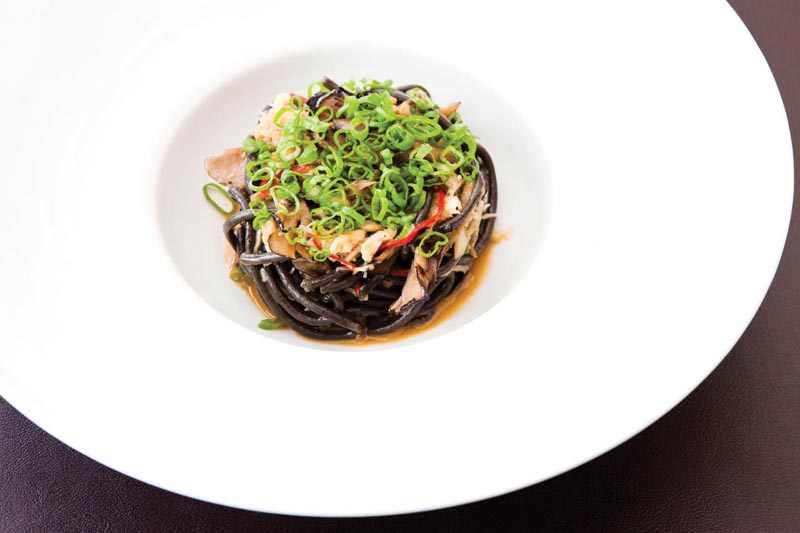Taste New American-Italian-Korean flavors at New York City’s Piora
by MICHELLE LEE
What is New American-Italian-Korean cuisine exactly? The simplest answer, of course, is to say that it’s what you get when you dine at Piora in New York City’s West Village. At Piora, which celebrates its one year anniversary next month, partners Simon Kim and Chris Cipollone set out to create a menu that blends their Korean and Italian heritages, respectively, but in as authentic a way as possible.
The result is a menu peppered with innovative dishes that are delicious and beautifully presented, though perhaps unrecognizably Korean, at first glance. Upon first taste, however, bold Korean flavors are transformed into a new realm of flavor profile. This is particularly displayed in their popular bucatini, a pasta dish inspired by seafood Kim and Cipollone had while in South Korean port city of Busan.
“At one place, they picked a big king crab and they steamed it and served it to us, and I vividly remember it being the best tasting crab,” said Kim. “It inspired our squid-ink bucatini, which has black garlic, Dungeness crab meat, maitake mushrooms and Fresno chili pepper. Even though there isn’t any distinct Korean ingredient, all my Korean friends say it tastes very Korean because of the similar texture and taste.”
When Kim, who has managed for major restaurant groups such as Thomas Keller and Jean-Gorges Vongerichten, set out to start his own restaurant, he deliberately wanted to tap a chef who didn’t learn Korean flavors or techniques in the U.S. “I wanted to partner with a chef … with a clean slate, who I could introduce to Korean cuisine,” explained Kim, who immigrated to New York from Korea around middle-school age.
He seemed to find an ideal match in Cipollone, an Italian American and native New Yorker praised for his cooking at Manhattan’s Tenpenny, but interested in challenging himself with new techniques and unfamiliar cuisines. “Simon and I went on a two-week trip to Korea … literally waking up and eating seven meals a day, as Simon translated,” said Cipollone.
The tour included major cities like Seoul, Jelado and Jeonju, as well as the countryside and seaside, highlighting such dishes as Jeonju bibimbap and Buhan bajirak juk, or Korean clam porridge. “I’ve had Korean food in terms of late night chicken wings and barbeque before, but I never had real Korean food in terms of the traditions, fermentation and regional differences,” Cipollone said. “I was especially blown away by the old-school places that specialize in the way people have been [cooking] for centuries.”
Piora’s barbequed octopus dish was directly inspired by his experience in Korea, yet also influenced by Cipollone’s American, French and Italian techniques. “They took the live octopus, skewered it, charred it and flavored it with gochujang (red pepper paste) right on the spot,” remembered Cipollone. “For our dish, I braised the octopus in gochujang and a traditional French shellfish stock and grilled it with this oceanic barbeque sauce brushed on.”
With such dishes, Cipollone said that he and Kim are trying to create the most delicious food they can, rather than “forcing Korean food into a pasta dish or doing Italian-Korean fusion.” It’s an approach that’s getting noticed by the likes of the New York Times and the New Yorker, which playfully poked at the level of attention to detail at Piora (“That dedication is extended to just about everything. Dishes are sometimes so involved that the waiters seem to be reciting soliloquies rather than specials,” the New Yorker reviewer wrote.).
Korean ingredients like soy sauce, sesame and jujube (a Korean date used in Piora’s American Rohan duck dish) are all imported from South Korea, incidentally. Authenticity is that important to the owners of Piora, which means “to blossom” in Korean, and pio also means “devout” in Italian. “We don’t break rules, but we’re not bound by tradition either,” said Cipollone. “And I think that’s what sets us apart and where we succeed.”
Images courtesy of Piora
This article was published in the June 2014 issue of KoreAm. Subscribe today! To purchase a single issue copy of the June issue, click the “Buy Now” button below. (U.S. customers only. Expect delivery in 5-7 business days).






